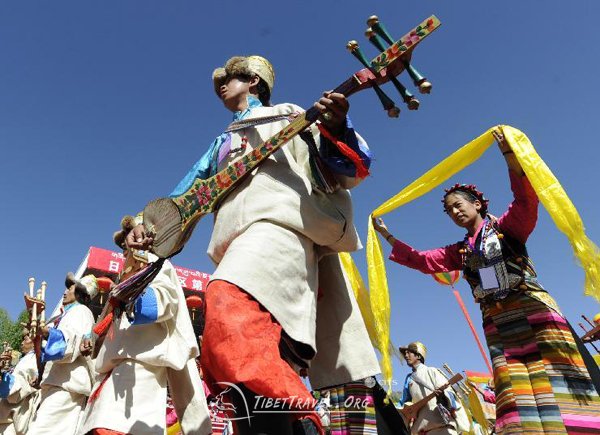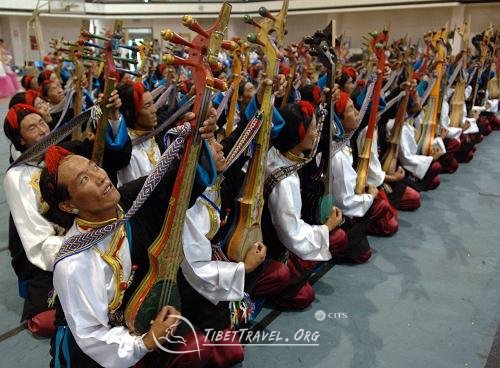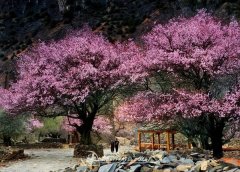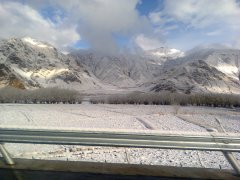When you travel to Tibet, you are highly recommended to watch a Tibetan singing and dancing show. Tibetan music and dance have been kept alive in Tibetan areas. At parties individuals are often asked to sing, and groups may dance. The songs offer greetings and good wishes or tell stories of drinking chang (Tibetan beer) or of lost love.
Themes and styles of Tibetan music and dance vary greatly depending on the region in Tibet the songs are from. Folk songs are usually sung a capella or to the accompaniment of the pi wang (fiddle) or the dran yen (long-necked lute). Most folk dances are performed in a circle.
Tibetan traditional music featuring vivid flavor and diversified forms includes folk music, sacred music, and royal court music. The folk music occupies an important position among the traditional music. It includes folk song, singing and dancing music, talking and singing music, opera music and instrumental music. The folk music popular in the U-Tsang dialect area, Kham dialect area, and Amdo dialect area differ clearly in style and music genres within the three areas also are not completely the same.
(1) Folk Song
Yamyipo folk song includes mountain song, work song, long song, custom song and sutra praying.
(2) Singing and Dancing Music
Tibetan folk singing and dancing posses diversified forms and bright features. Its lyrics are drawn from vast numbers of subjects, some eulogizing the sun, moon, and stars, mountain, river and mother earth, some lauding the faces and clothes of women. Other subjects include religious beliefs and the wishing of blessings. Since the 1950s, the masses also have compiled many lyrics reflecting the new life.
(3) Talking and Singing Music
Tibetan talking and singing music is performed mainly by the folk artists and monks.
(4) Opera music
Tibetan Opera includes four genres of drama, Tibetan opera (Ace Lhamo), Amdo Tibetan opera, Dege Tibetan opera and Qamdo Tibetan opera. Among them, Tibetan opera and Amdo Tibetan opera are more popular and have greater influence. Each genre boasts different musical styles, performance and costumes.
Tibetan opera has a long history and its origin may be traced back to the Khrisong Detson Period in the eighth century. At the inauguration of the Samye Monastery, the artists, combining the Tibetan folk dance with the Buddhist stories, performed a kind of pantomimic dancing ritual. In the past, it was performed in the open air and accompanied only by drums and small cymbals. Since the founding of the People's Republic of China, Tibetan opera has been on the stage, and the aria and band have been reformed, thus enriching the expressive force of the music of Tibetan opera.











.jpg)




0 Comment ON "Tibetan music and dance"